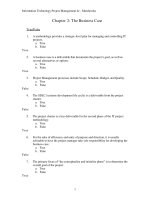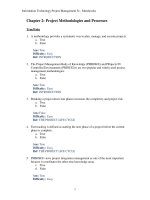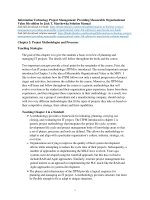Lecture Information technology project management - Chapter 2: The project management context and processes
Bạn đang xem bản rút gọn của tài liệu. Xem và tải ngay bản đầy đủ của tài liệu tại đây (584.62 KB, 33 trang )
Chapter 2:
The Project Management
Context and Processes
adopted from PMI’s PMBOK 2000 and
Textbook : Information Technology Project Management
(author : Dr. Kathy Schwalbe)
1
contents
•
Three Sphere Model
– system philosophy, system analysis and system management
•
Project Life Cycle
– Concept, development, implementation and support
•
•
•
•
•
•
•
Project life cycle vs product life cycle
Management reviews in project phases
organization structure
Success factors in project management
Project Management job functions : 15
Skill required in project manager
Project management process:
– initiating, planning, executing, controlling and closing
•
PM processes vs knowledge areas
Chapter 2
2
Projects Cannot Be Run In Isolation
• Projects must operate in a broad
organizational environment
• Project managers need to take a holistic or
systems view of a project and understand
how it is situated within the larger
organization
• See example in opening and closing case
to illustrate this concept
Chapter 2
3
A Systems View of Project
Management
• A systems approach emerged in the 1950s to
describe a more analytical approach to
management and problem solving
• Three parts include:
– Systems philosophy
• View things as systems, interacting components working
within an environment to fulfill some purpose
– Systems analysis
• problemsolving approach
– Systems management
• Address business, technological, and organizational issues
before making changes to systems
4
Figure 21. Three Sphere Model
for Systems Management
5
Project Life Cycle and Project
phases
• A project life cycle is a collection of
project phases
• Project phases vary by project or industry,
but some general phases include
–
–
–
–
concept
development
implementation
support
Chapter 2
6
Figure 22. Project Life Cycle and
Project Phases
7
Product Life Cycles
• Products also have life cycles
• The Systems Development Life Cycle
(SDLC) is a framework for describing the
phases involved in developing and
maintaining information systems
• Typical SDLC phases include planning,
analysis, design, implementation, and
support
Chapter 2
8
Sample SDLC Models
• Waterfall model: has welldefined, linear stages
of systems development and support
• Spiral model: shows that software is developed
using an iterative or spiral approach rather than a
linear approach
• Incremental release model: provides for
progressive development of operational software
• RAD model: used to produce systems quickly
without sacrificing quality
• Prototyping model: used for developing
prototypes to clarify user requirements9
Figure 23. Spiral Model of Software
Development (Boehm, 1988)
10
Project Life Cycles vs Product
Life Cycles
• The project life cycle applies to all projects,
regardless of the products being produced
• Product life cycle models vary considerably
based on the nature of the product
• Most large IT products are developed as a series
of projects
• Project management is done in all of the product
life cycle phases
Chapter 2
11
Why Have Project Phases and
Management Reviews?
• A project should successfully pass through
each of the project phases in order to
continue on to the next
• Management reviews (also called phase
exits or kill points) should occur after each
phase to evaluate the project’s progress,
likely success, and continued compatibility
with organizational goals
Chapter 2
12
What Went Right?
"The real improvement that I saw was in our ability to in
the words of Thomas Edison know when to stop beating a
dead horse.…Edison's key to success was that he failed
fairly often; but as he said, he could recognize a dead
horse before it started to smell...as a result he had 14,000
patents and was very successful…In IT we ride dead
horses failing projects a long time before we give up.
But what we are seeing now is that we are able to get off
them; able to reduce cost overrun and time overrun. That's
where the major impact came on the success rate.”
Cabanis, Jeannette, "'A Major Impact': The Standish Group's Jim Johnson On
Project Management and IT Project Success," PM Network, PMI, September
1998, p. 7
Chapter 2
13
Understanding Organizations
Structural frame:
Focuses on roles and
responsibilities,
coordination and control.
Organization charts help
define this frame.
Human resources frame:
Focuses on providing
harmony between needs of
the organization and needs
of people.
Political frame:
Assumes organizations
are coalitions composed
of varied individuals and
interest groups. Conflict
and power are key issues.
Symbolic frame: Focuses
on symbols and meanings
related to events. Culture
is important.
14
What Went Wrong?
Many data warehousing projects are sidetracked or derailed completely
by politics. Data warehousing projects are always potentially political
because they cross departmental boundaries, change both the terms of
data ownership and data access, and affect the work practices of highly
autonomous and powerful user communities. Many organizations fail to
admit that many data warehousing projects fail primarily because
management and project teams do not understand and manage politics.
Marc Demarest found over 1200 articles on the topic of data
warehousing based on a journal search he did from July 1995 to July
1996. Many of those articles offer advice on how to run successful data
warehousing projects and focus on the importance of design, technical,
and procedural factors, when, in fact, political factors are often the most
important in helping these projects succeed.
Chapter 2
15
Many Organizations Focus on
the Structural Frame
• Most people understand what organizational
charts are
• Many new managers try to change organizational
structure when other changes are needed
• 3 basic organization structures
– functional
– project
– matrix
Chapter 2
16
Figure 24. Functional, Project, and
Matrix Organizational Structures
17
Table 21. Organizational Structure
Influences on Projects
Organization Type
Project
Characteristics
Project Manager's
Authority
Percent of Performing
Organization's
Personnel Assigned Full
time to Project Work
Project Manager's Role
Common Title for
Project Manager's Role
Project Management
Administrative Staff
Functional
Weak Matrix
Little or
None
Limited
Virtually
None
025%
Parttime
Project
Coordinator/
Project Leader
Parttime
Matrix
Balanced
Matrix
Low to
Moderate
Strong Matrix
Projectized
Moderate
To High
High to
Almost Total
1560%
5095%
85100%
Parttime
Project
Coordinator/
Project Leader
Fulltime
Project
Manager/
Project Officer
Fulltime
Project
Manager/
Program Manager
Fulltime
Project
Manager/
Program Manager
Parttime
Parttime
Fulltime
Fulltime
PMBOK Guide, 2000, p. 19
The organizational structure influences the project
manager’s authority, but remember to address the human
resources, political,and symbolic frames, too.
18
Recognize the Importance of
Project Stakeholders
• Recall that project stakeholders are the people
involved in or affected by project activities
• Project managers must take time to identify,
understand, and manage relationships with all
project stakeholders
• Using the four frames of organizations can help
meet stakeholder needs and expectations
• Senior executives are very important stakeholders
Chapter 2
19
Table 22. What Helps Projects
Succeed?
• According to the Standish Group’s report CHAOS 2001:
A Recipe for Success, the following items help IT projects
succeed, in order of importance:
–
–
–
–
–
–
–
–
–
Executive support
User involvement
Experience project manager
Clear business objectives
Minimized scope
Standard software infrastructure
Firm basic requirements
Formal methodology
Reliable estimates
Chapter 2
20
Need for Top Management
Commitment
• Several studies cite top management commitment
as one of the key factors associated with project
success
• Top management can help project managers
secure adequate resources, get approval for
unique project needs in a timely manner, receive
cooperation from people throughout the
organization, and learn how to be better leaders
Chapter 2
21
Need for Organizational Commitment to
Information Technology (IT)
• If the organization has a negative attitude
toward IT, it will be difficult for an IT
project to succeed
• Having a Chief Information Officer (CIO)
at a high level in the organization helps IT
projects
• Assigning nonIT people to IT projects
also encourage more commitment
Chapter 2
22
Need for Organizational
Standards
• Standards and guidelines help project managers
be more effective
• Senior management can encourage
– the use of standard forms and software for project
management
– the development and use of guidelines for writing
project plans or providing status information
– the creation of a project management office or center
of excellence
Chapter 2
23
Table 23. Fifteen Project
Management Job Functions*
• Define scope of project
• Identify stakeholders, decision
makers, and escalation
procedures
• Develop detailed task list (work
breakdown structures)
• Estimate time requirements
• Develop initial project
management flow chart
• Identify required resources and
budget
•
•
•
•
•
•
•
•
Evaluate project
requirements
Identify and evaluate risks
Prepare contingency plan
Identify interdependencies
Identify and track critical
milestones
Participate in project phase
review
Secure needed resources
Manage the change control
process
Report project status
*Northwest Center for Emerging Technologies, "Building a Foundation for Tomorrow:
Skills Standards for Information Technology,"Belleview, WA, 1999 24
Suggested Skills for a
Project Manager
Communication skills: listening, persuading
Organizational skills: planning, goalsetting, analyzing
Team Building skills: empathy, motivation, esprit de
corps
Leadership skills: sets example, energetic, vision (big
picture), delegates, positive
Coping skills: flexibility, creativity, patience, persistence
Technological skills: experience, project knowledge
Chapter 2
25









